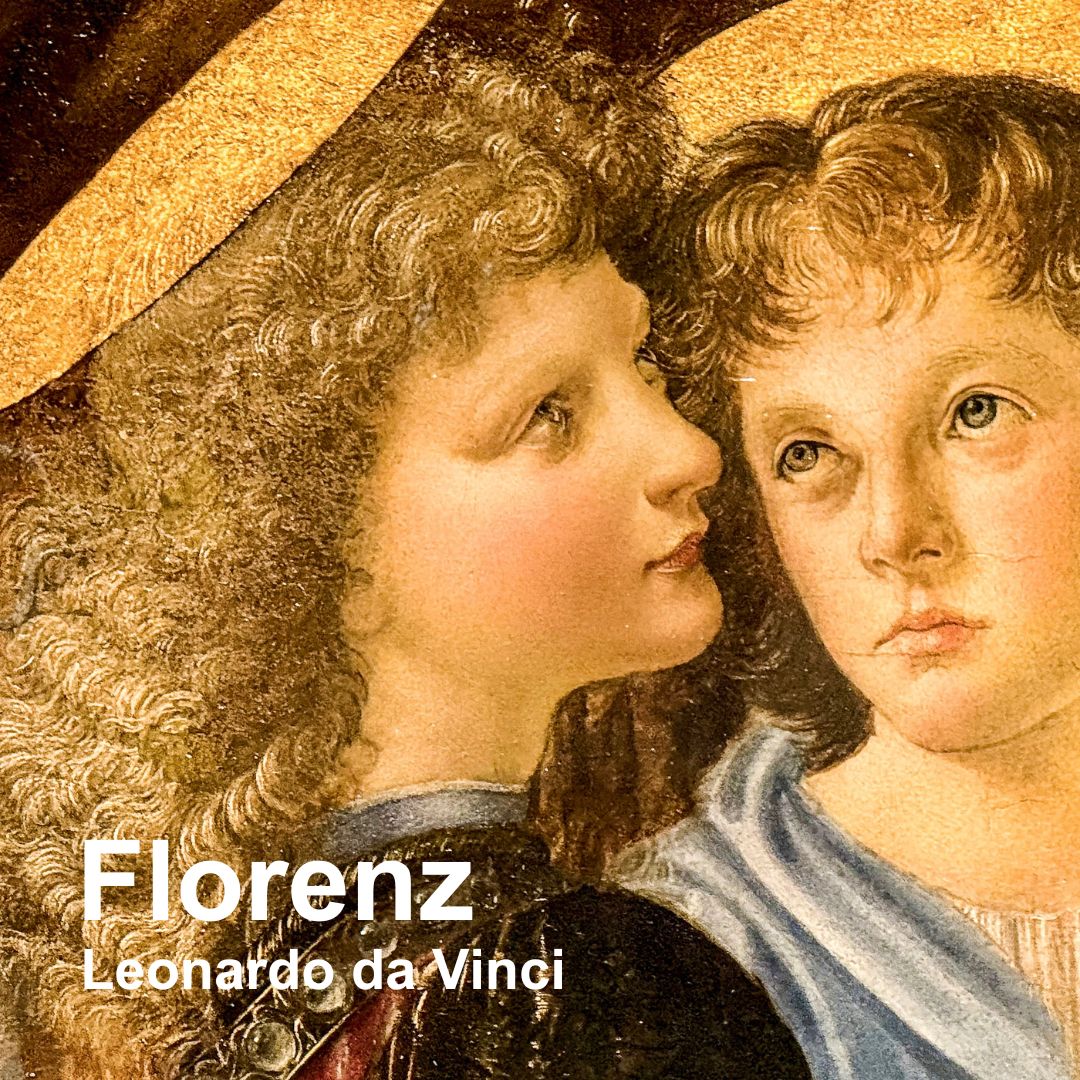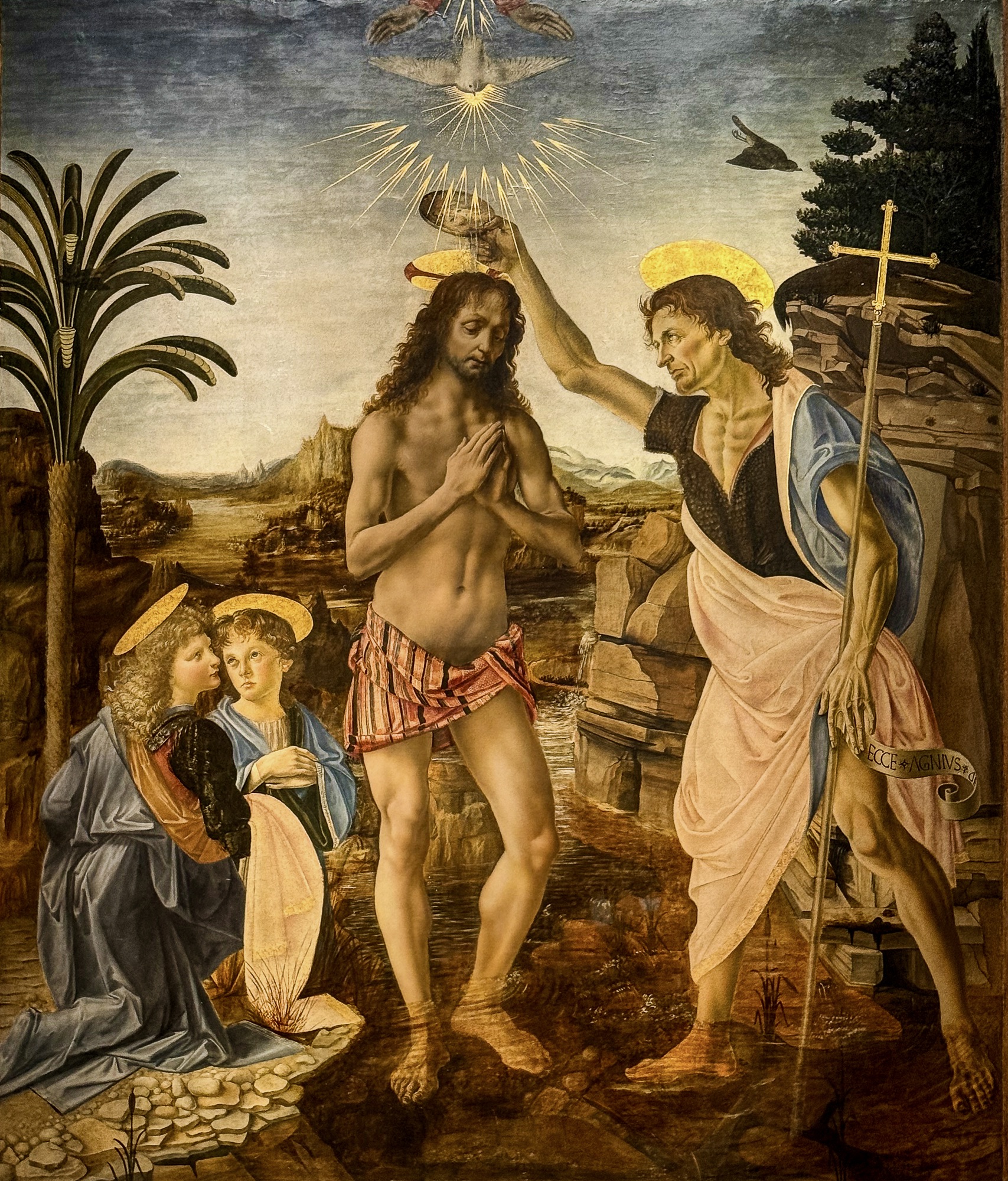
Florenz – Leonardo da Vinci (1552-1521) und Andrea del Verrocchio (um 1435-1488), Taufe Christi, 1472/75, Tempera und Öl auf Holz, 177 x 151 cm, Uffizien
Ausgeführt in Tempera, ist das malerische Hauptwerk des Bildhauers und Malers Verrocchio von Plastizität und zeichnerischer Präzision bestimmt. Nicht ganz vollendet, führt Leonardo fehlende Bereiche aus, wie links die landschaftliche Ferne und den vorderen Engel.
Executed in tempera, the main painterly work by the sculptor and painter Verrocchio is characterized by plasticity and graphic precision. Not quite finished, Leonardo fills in missing areas, such as the landscape in the distance on the left and the angel in front.
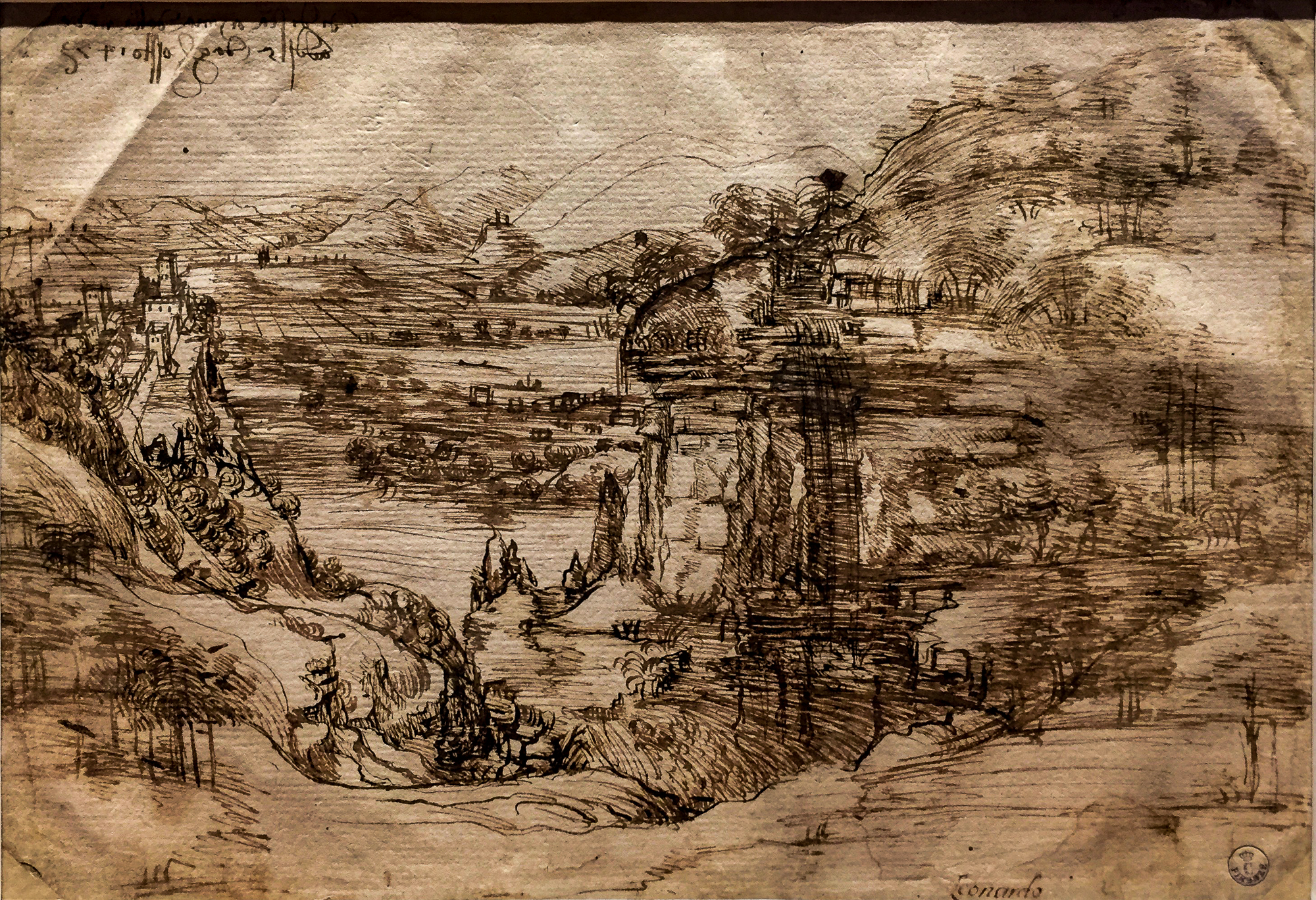
Leonardo, Landschaft mit Fluss, 1473, Feder in Braun, 19,7 x 28,6 cm, Uffizien, Gabinetto dei Disegni, Inv. Nr. 8 P – aufgenommen im Juni 2016
Der Linkshänder schreibt wie stets in Spiegelschrift. Oben links hält er den Entstehungstag fest, den 5. August 1473. Mit großer Leidenschaft skizziert der junge Mann eine Gegend in der Nähe seines Geburtsortes Vinci. Dabei entsteht die erste freie Landschaftsdarstellung der europäischen Kunst. Die Verwandtschaft mit dem Hintergrund in Verrocchios Gemälde ist offensichtlich.
As always, the left-handed artist writes in mirror writing: at the top left, he records the date of creation, August 5, 1473. Leonardo sketches an area near his birthplace of Vinci with great passion. The result is the first free landscape depiction in European art. The relationship with the background in Verrocchio’s painting is obvious.
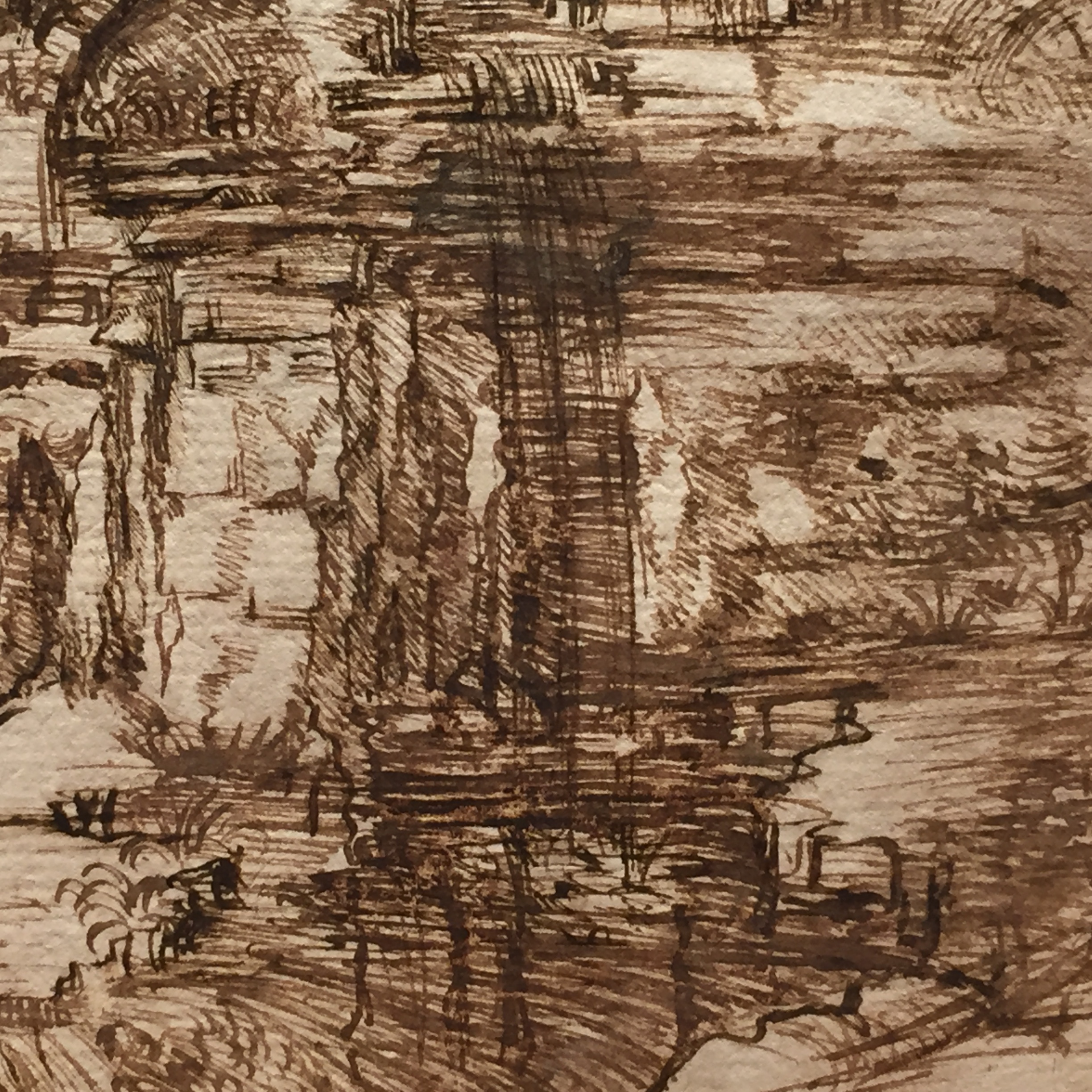
Detail des vorigen.
Das berühmteste Engelspaar neben dem in Raffaels Sixtinischer Madonna
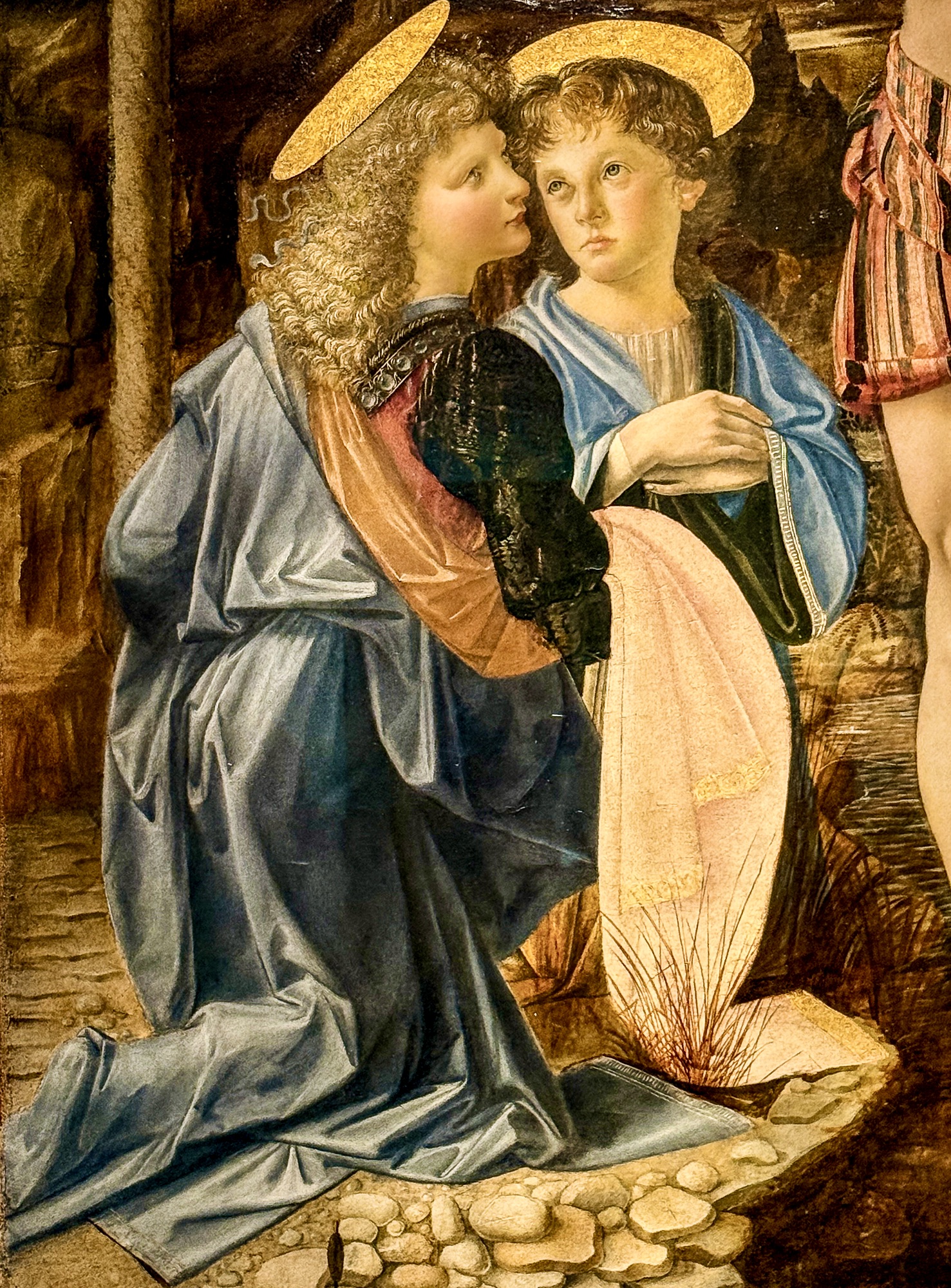
Detail des vorigen. Mit dem rechten Engel malt Verrocchio in Tempera ein wunderbares Frührenaissance-Gesicht mit frommem Augenaufschlag. Der junge Leonardo aber überbietet mit seiner Ölmalerei und den nuancenreichen Abstufungen von Licht- und Schattenpartien seinen doppelt so alten Meister bei weitem. Zeichnung, Farbe, Gewandfalten und Ausdruck erreichen ein zuvor nicht gekanntes Niveau.
Detail of the previous one. In the angel on the right, Verrocchio paints a wonderful early Renaissance face in tempera with a pious look in his eyes. With his oil painting and the nuanced gradations of light and shadow, however, the young Leonardo far surpasses his master twice his age. Drawing, color, folds and expression reach an unprecedented level.
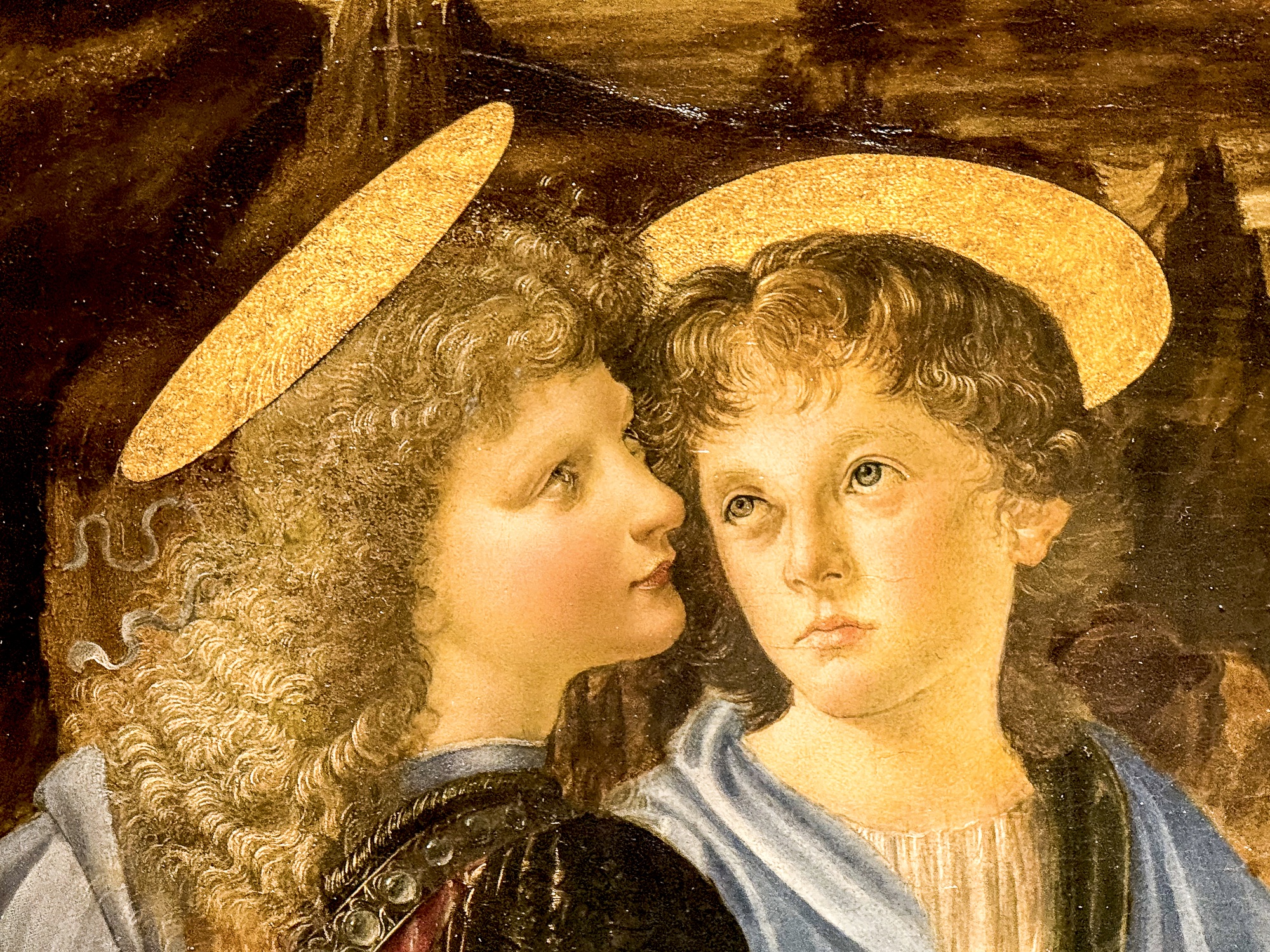
Sprachlos macht der Gesichtsausdruck des linken Engels, die Modulation seiner Züge, der Lockenglanz der Haaresfülle. Daneben wirkt Verrocchios Engel, obgleich auch von zartem Ausdruck, eher bieder und ausdrucksarm. Laut Giorgio Vasari soll sich Verrocchio wegen der Überlegenheit Leonardos entschlossen haben, keinen Pinsel mehr anzurühren.
The facial expression of the angel on the left, the modulation of his features, the curly sheen of the fullness of his hair leave us speechless. Verrocchio’s angel appears almost bland and inexpressive in comparison. According to Giorgio Vasari, Verrocchio is said to have decided not to touch a brush again because of Leonardo’s superiority.
Weibliche Schönheit wie nie zuvor dargestellt
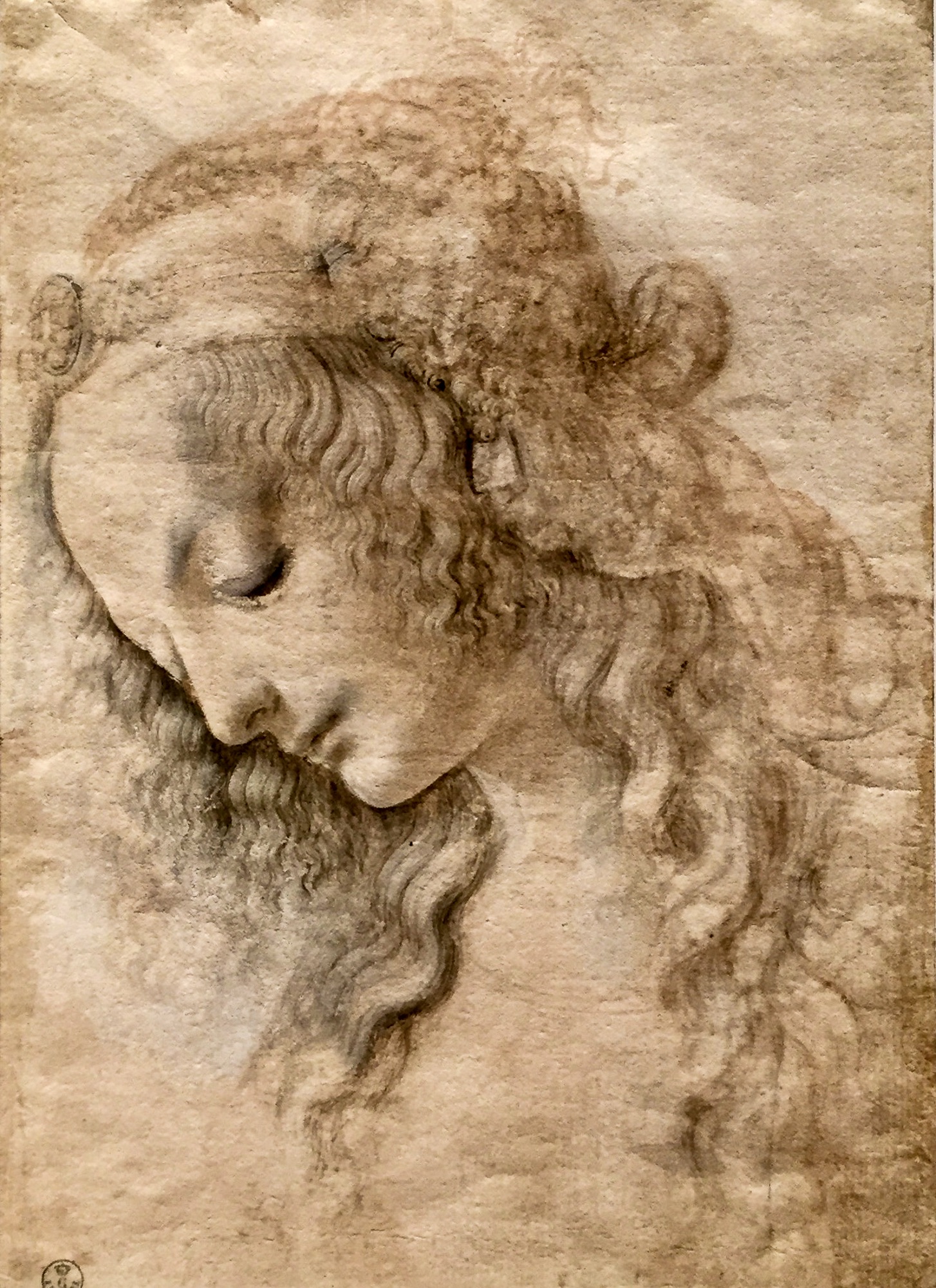
Leonardo, Kopf einer jungen Frau mit lockigem Haar, Feder und Pinsel in Braun, 21,1 x 29,6 cm, Uffizien, Gabinetto dei Disegni, Inv. Nr. 428 E – aufgenommen im Juni 2016
Gedeutet teils als Studie für eine Maria der Verkündigung, handelt es sich wohl wegen des reichen Haarschmucks – als Zeichen früherer Eitelkeit – eher um eine Maria Magdalena. Die Zartheit teilt sie mit dem Engel der Taufe Christi.
Interpreted in part as a study for a Mary of the Annunciation, it is more likely to be a Mary Magdalene due to the rich hair ornament – a sign of earlier vanity. She shares her delicacy with the angel of Christ’s baptism.
Florenz – Leonardo da Vinci: Verkündigung
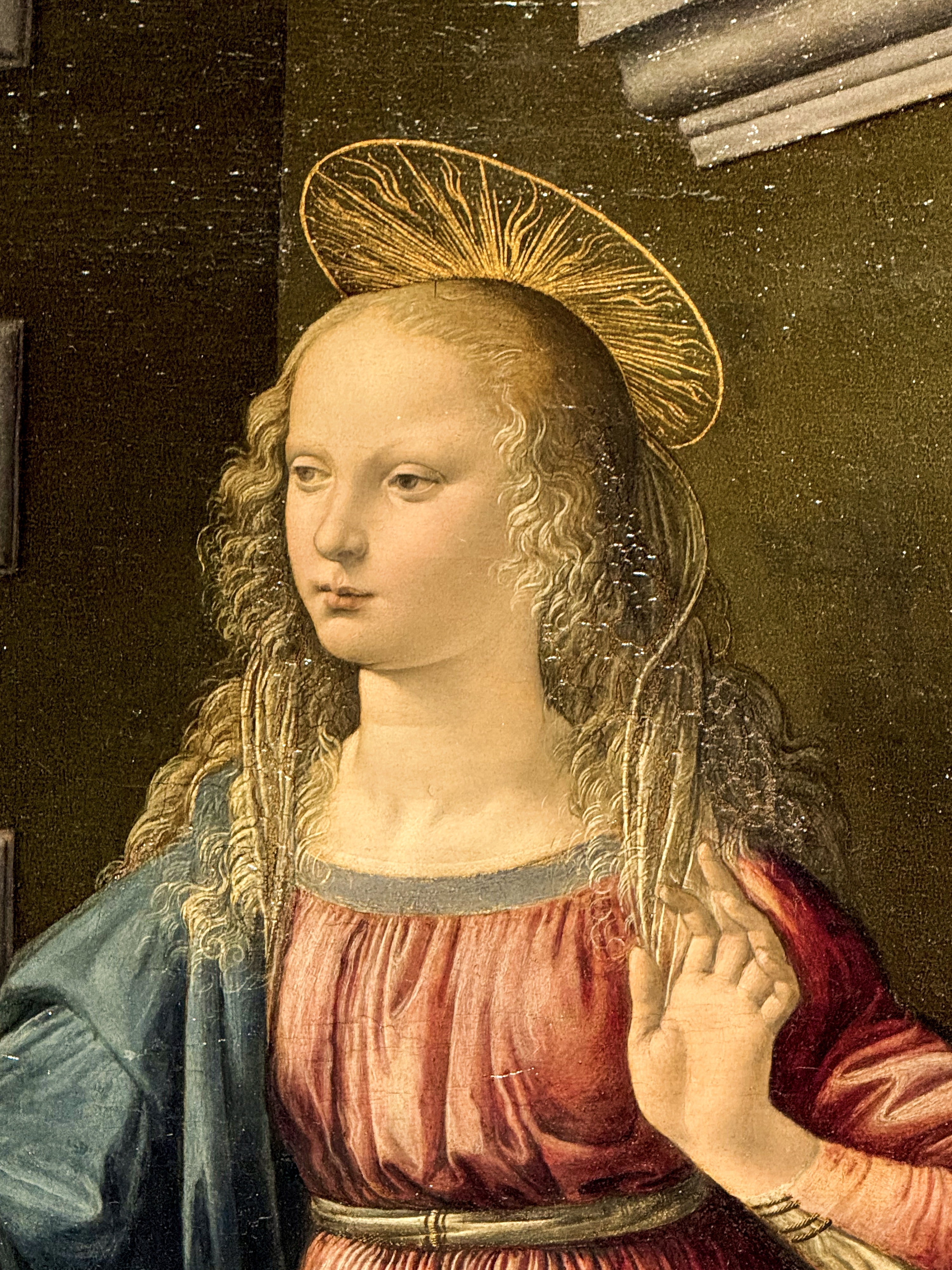
Leonardo, Verkündigung an Maria, Detail des folgenden.
Das erste eigenständige Frühwerk des aufblühenden Genies mit einer mädchenhaften Maria, die Überraschung und würdige Haltung miteinander verbindet.
The first independent early work by the blossoming genius: a girlish Maria that combines surprise and dignified poise.
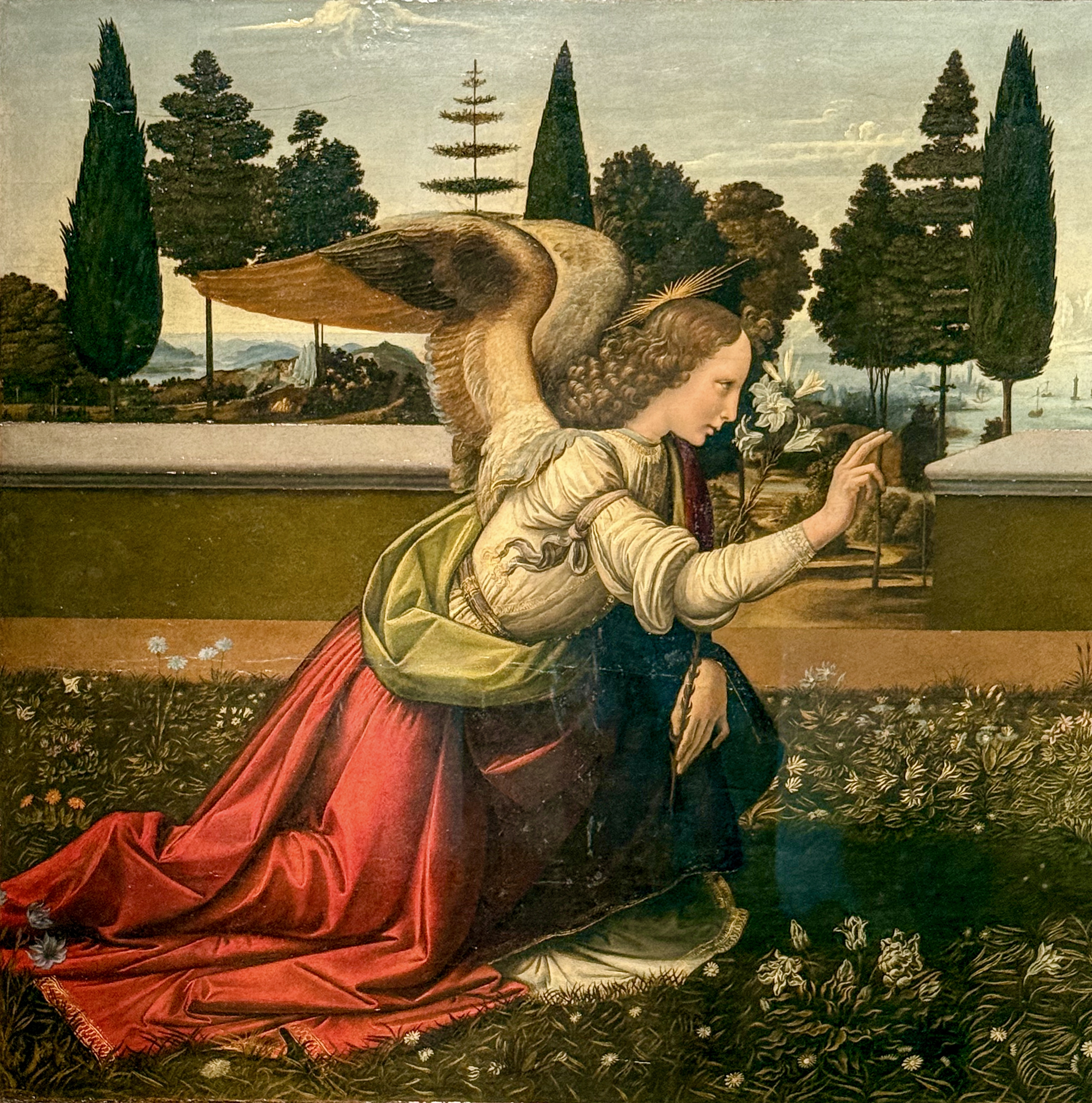
Detail des folgenden. Der Verkündigungsengel mit seinem schönen Profil und genauso eleganten Handhaltungen wie Maria ist eine himmlisch elegante Erscheinung. Darüber hinaus hat er Flügel, die genauestes Naturstudium verraten.
The angel of the Annunciation with his beautiful profile and equally elegant hand positions as Mary is a heavenly and elegant appearance. He also has wings that reveal the most precise study of nature.
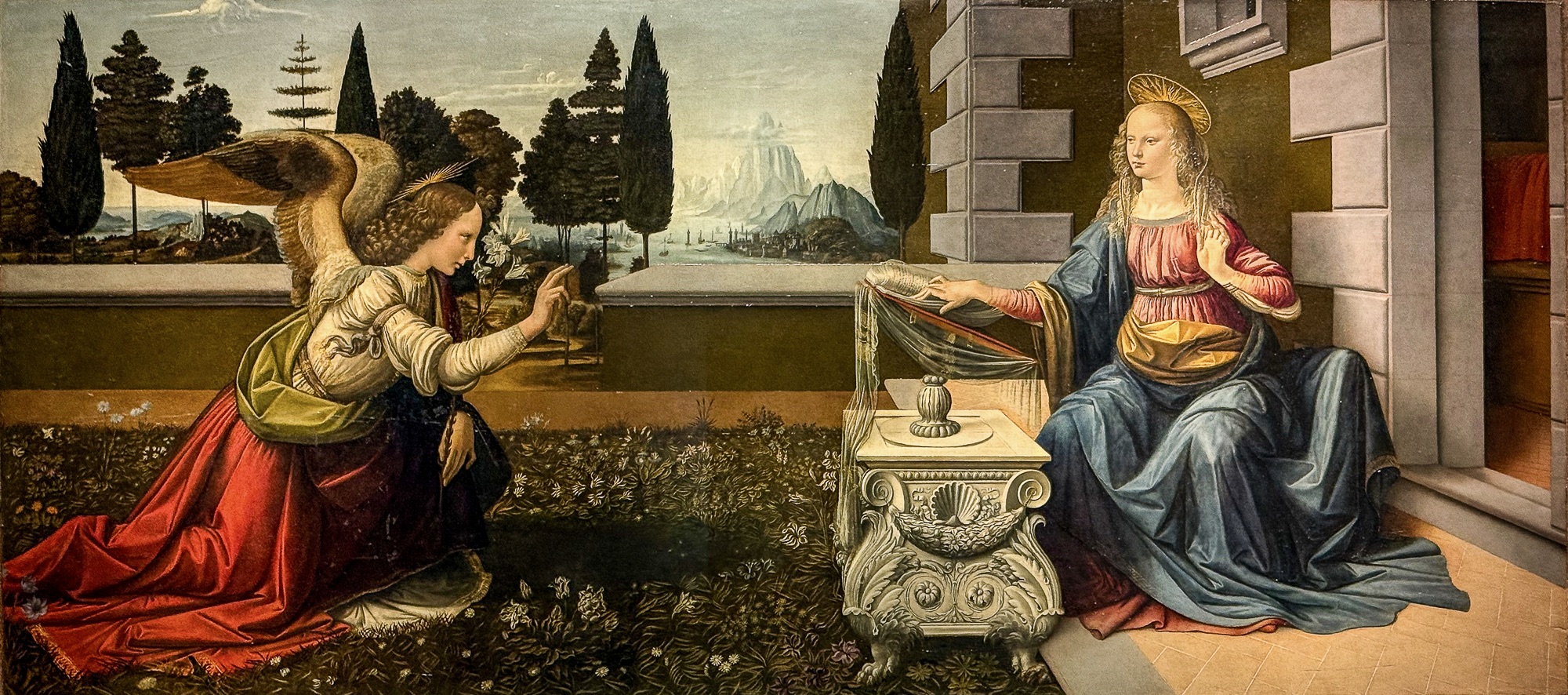
Leonardo, Verkündigung an Maria, 1472/75, Öl und Tempera auf Holz, 98 x 217 cm, Uffizien, Inv. Nr. 1618
Leonardos überraschendes Querformat zeigt nicht wie meist einen Innenraum, vielmehr einen breit gestreckten hortus conclusus, einen geschlossenen Garten, als Zeichen der marianischen Reinheit. Dahinter in der Ferne eine weite Wasser- und Gebirgslandschaft. Vgl. den Faltenwurf von Marias Mantel mit dem des Engels bei der Taufe Christi. Die zeitliche Nähe liegt auf der Hand.
Leonardo’s surprising horizontal format does not show an interior, as is usually the case, but rather a broad hortus conclusus, an enclosed garden, as a sign of Marian purity. Behind it in the distance is a vast landscape of water and mountains. Cf. the drapery of Mary’s cloak with that of the angel of Christ’s baptism. The temporal proximity is obvious.
Eine Mantellandschaft
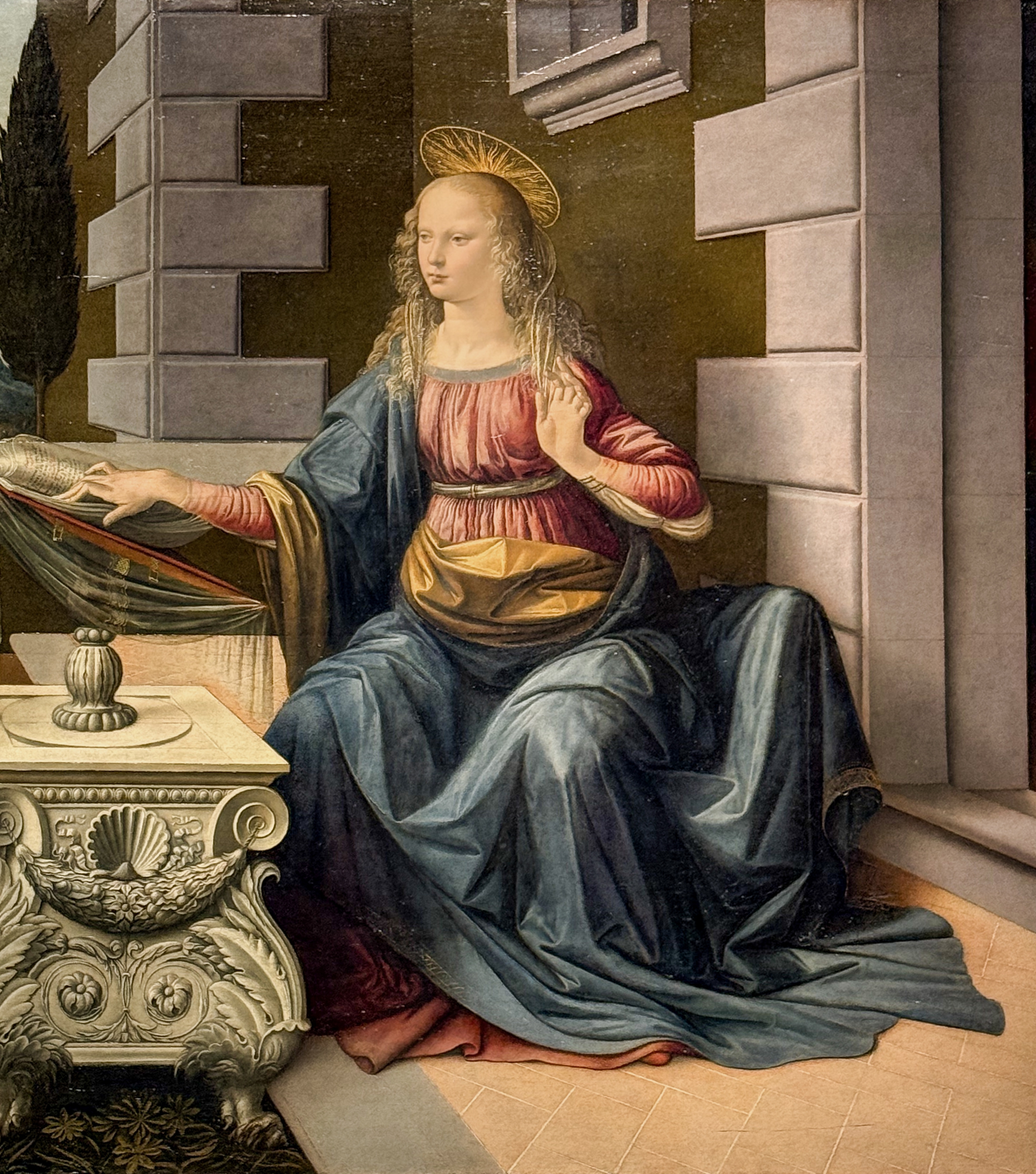
Detail des vorigen. Ein solches Prachtgewand wie dieser Mantel ist wahrscheinlich in der Werkstatt drapiert worden und zwar über in Ton oder Wachs nachgebildete Körperteile. Lehmgetränkte Tücher darüber stabilisieren die gewünschte Form. Das erlaubt Licht- und Schattenstudien in Ruhe. Vgl. Leonardos Gewandstudie Saint-Morys im Louvre.
A magnificent garment such as this cloak was probably draped in the workshop over body parts modeled in clay or wax. Cloths soaked in clay stabilize the desired form. This allows light and shadow studies to be made in peace. Cf. Leonardo’s study of Saint-Mory’s robe in the Louvre.
Florenz – Leonardo da Vinci: Anbetung der Könige
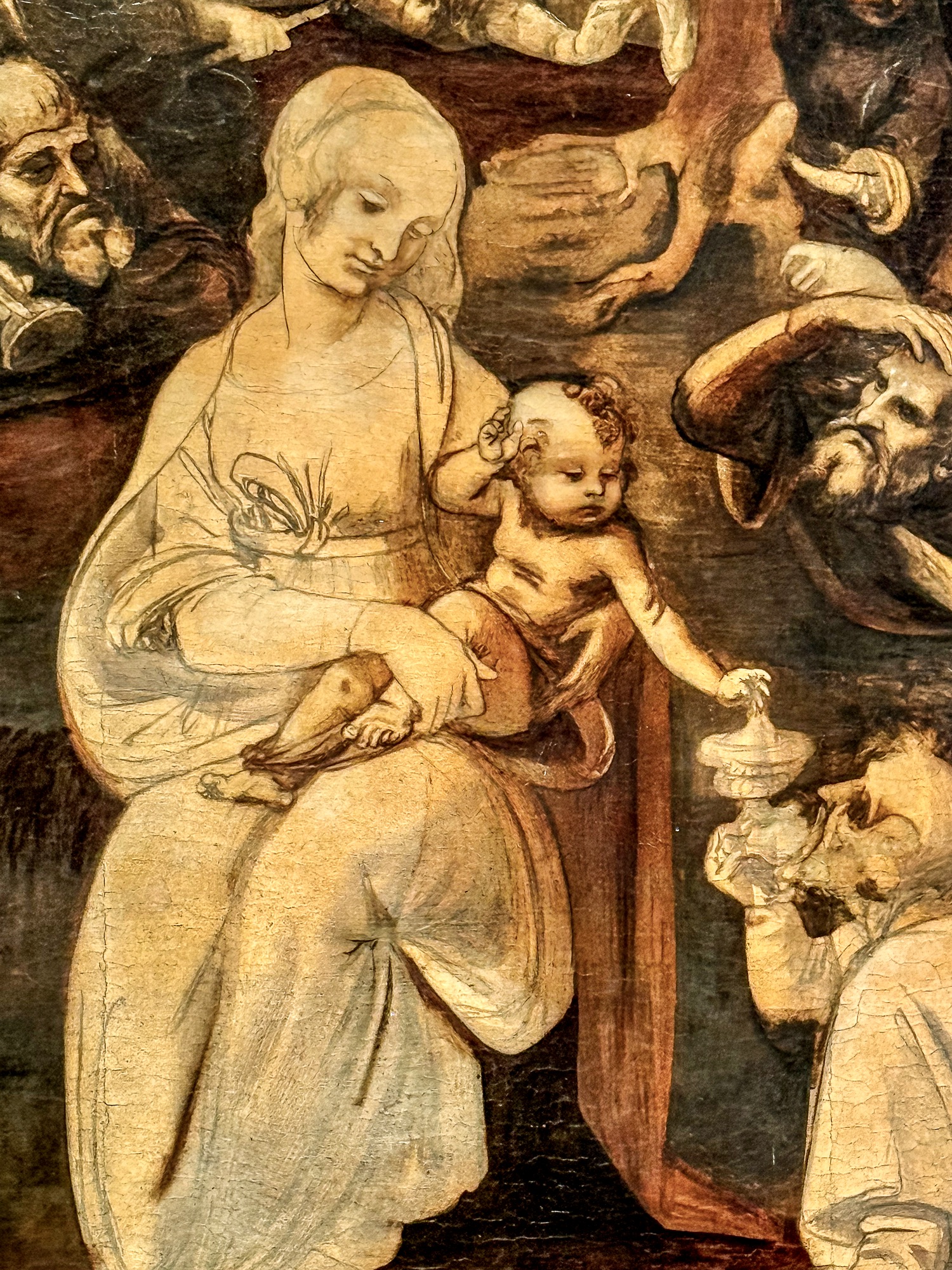
Leonardo, Detail des folgenden. Die Betrachtung der Anbetung der Könige beginnt mit dem großartigen Hauptmotiv. Maria hält ihr Kind auf dem Schoß. Es greift mit Neugier nach der Gabe des Königs, während es mit seiner Rechten eine kleine Segensgeste macht.
Das Gemälde insgesamt ist eines der zentralen Werke des Malers und der italienischen wie europäischen Kunst. In seiner Vielschichtigkeit ist es kaum zu fassen.
Leonardo, detail of the following. The contemplation of the Adoration of the Magi begins with the magnificent main motif. Mary is holding her child on her lap. She reaches with curiosity for the king’s gift while making a small gesture of blessing with her right hand.
The painting as a whole is one of the central works of the painter and of Italian and European art. Its complexity is almost impossible to grasp.
Florenz – Leonardo da Vinci: rätselhafte Pferdestudien
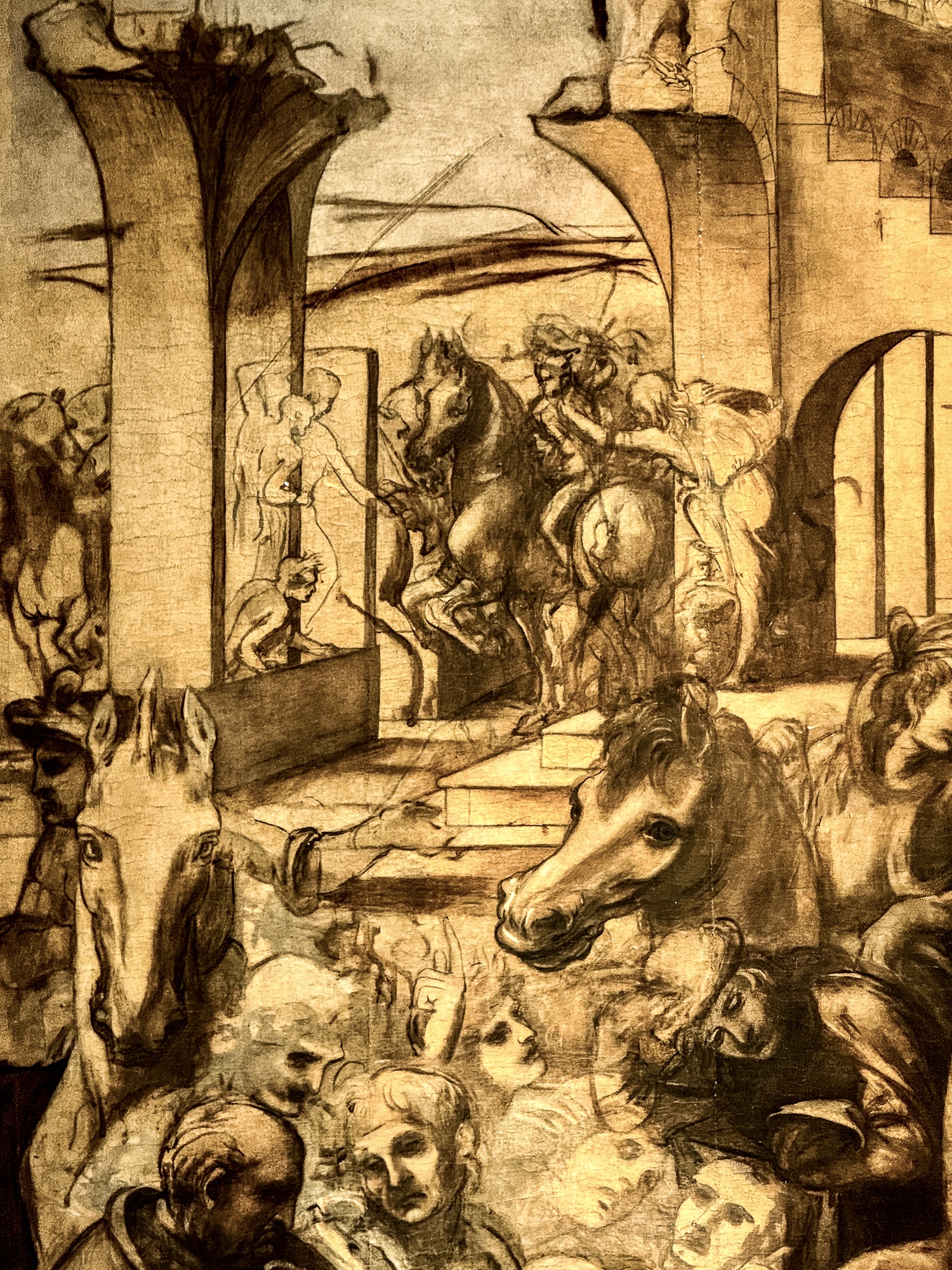
Vieles an Leonardos unvollendetem Bild bleibt rätselhaft. So die nicht fertig gestellte oder ruinöse Architektur im Hintergrund mit unerklärlichen Reiterszenen.
Much of Leonardo’s unfinished painting remains enigmatic. For example, the unfinished or ruined architecture in the background with inexplicable scenes of horsemen.
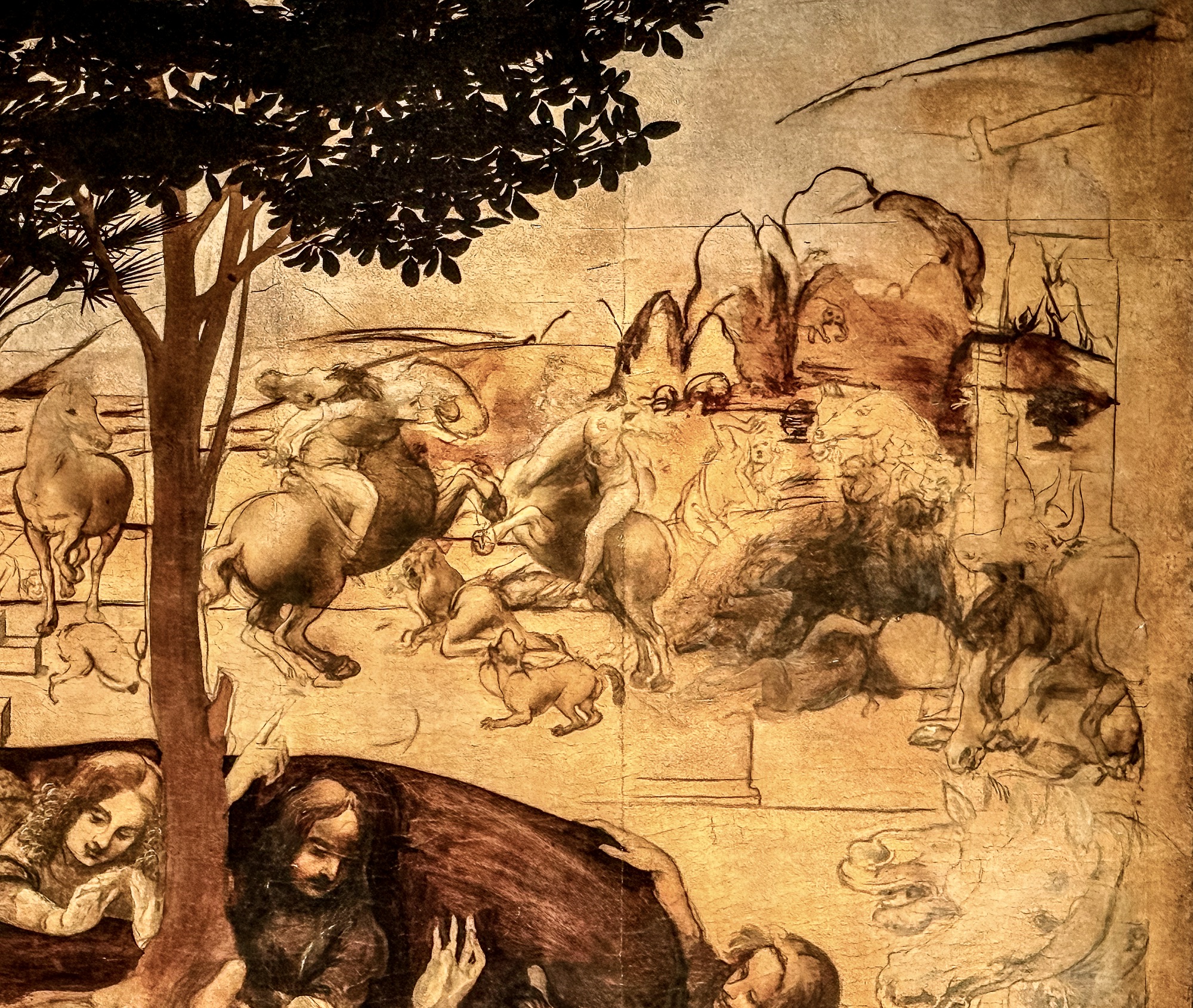
Rechter Hand hinten gibt es sogar einen Reiterkampf mit kläffenden Hunden. Aber auch in der Bildmitte, hier links, ein ruhiges Pferd ohne Reiter und rechts vorne große Pferdeköpfe.
There is even a horse fight with yapping dogs at the back right. But also in the center of the picture, here on the left, a calm horse without a rider and on the right in front large horse heads.
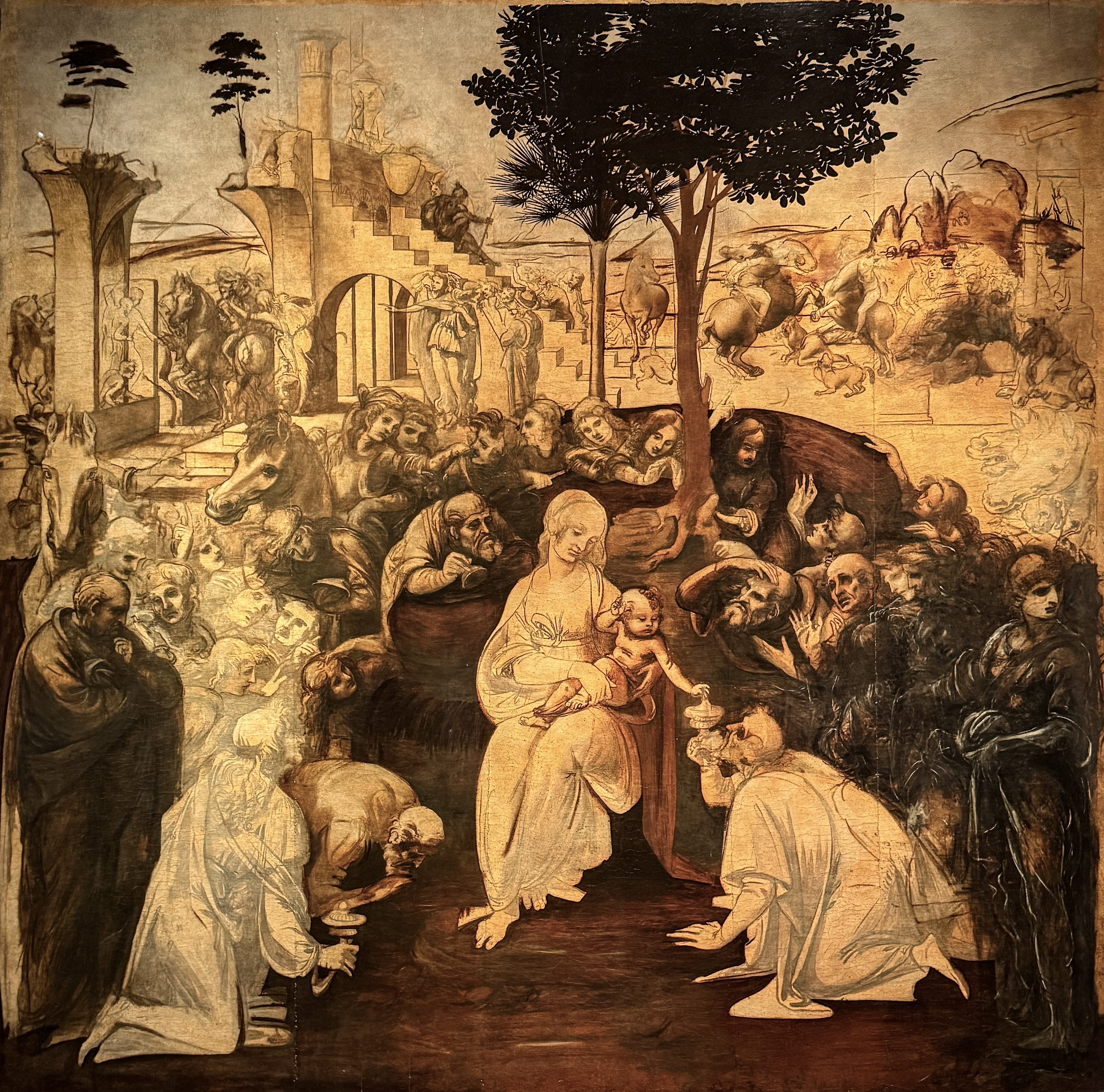
Leonardo, Anbetung der Könige, 1481/82, unvollendet, Öl auf Holz, 247 x 146 cm, Uffizien
Das große Gemälde war bestimmt für die Kirche San Donato in Scopeto außerhalb der Stadtmauern, nicht weit von der Porta Romana. Anders als üblich formen die Gestalten einen Halbkreis um Mutter und Kind. Vorne flankieren zwei Gestalten wie Wächter das Geschehen und geben dem Gewoge der kniefälligen Verehrung Halt. Die Deutung des Ganzen gibt Rätsel auf.
The large painting was intended for the church of San Donato in Scopeto outside the city walls, not far from the Porta Romana. Unlike usual, the figures form a semicircle around the mother and child. At the front, two figures flank the scene like guards and provide support for the throng of worshippers. The interpretation of the whole is a mystery.
Florenz – Leonardo da Vinci: ersetzt durch Filippino Lippi

Filippino Lippi, Anbetung der Könige, 1496, Holz, 258 x 243 cm, Uffizien
Ab 1482 ist Leonardo in Mailand für Ludovico Sforza tätig. Als absehbar ist, dass er seine Altartafel nicht vollenden wird, ergeht der Auftrag an Filippino Lippi. Wir kennen ihn von der Cappella Brancacci und werden ihm noch in der Badia Fiorentina, in Santo Spirito und Santa Maria Novella begegnen.
Filippino bietet in seinem Gemälde für San Donato in Scopeto eine Vielfalt von Gestalten und Aktivitäten in der Nähe und Ferne sowie eine bewegte Landschaft. Insgesamt ein reifes Werk der Spätphase der florentinischen Frührenaissance.
From 1482, Leonardo worked for Ludovico Sforza in Milan. When it became clear that he would not be able to complete his altarpiece, the commission was given to Filippino Lippi. We know him from the Cappella Brancacci and will encounter him in the Badia Fiorentina, Santo Spirito and Santa Maria Novella.
In his painting for San Donato in Scopeto, Filippino offers a variety of figures and activities near and far as well as an animated landscape. Overall, a mature work from the late phase of the early Florentine Renaissance.

Detail des vorigen. Anmut, Verehrung, Demut – vieles zeichnet auch hier Filippino aus und dennoch bleibt sein eindrucksvolles Altarbild immer im Schatten Leonardos.
Grace, reverence, humility – Filippino is also characterized by many things here, and yet his impressive altarpiece always remains in Leonardo’s shadow.
